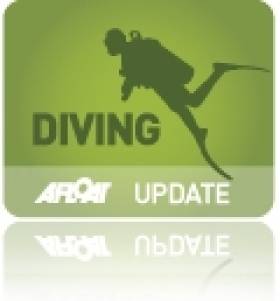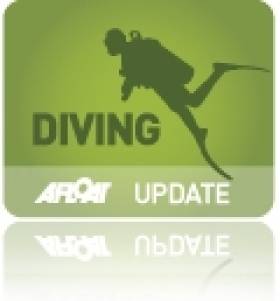Displaying items by tag: diving
#WaterSafety - Recreational divers must follow safety guidelines to the letter, a coroner has urged during the inquest into the death of two diving enthusiasts off West Cork last summer.
As previously reported on Afloat.ie, the two men in their 60s, who were understood to be experienced divers, died while exploring the wreck of a German U-boat off Castlehaven on 2 July last.
Cork City coroner Dr Myra Cullinane this week ruled misadventure in the deaths of 65-year-old Stephen Clarke from Surrey and 61-year-old Jonathan Scott from Western Australia, as the Irish Examiner reports.
The inquest heard that both men had overstayed their 'bottom time' at the wreck 42 metres below the surface and succumbed to the bends after making a rapid ascent.
It was also found that the duo's air regulators were not appropriate for operation at such depths, which would have made breathing difficult.
The Irish Examiner has much more on the story HERE.
Elsewhere, an Irish student who was paralysed while diving into the water at a Portuguese beach in 2012 has spoken of the moment that changed his life forever.
Jack Kavanagh was an experienced lifeguard and surfing instructor before the dive into a hidden sandbank that broke his neck with a "little click".
But as the 22-year-old tells the Irish Mirror: "I was very calm. I knew immediately what had happened. I was so used to being in the water so I didn't panic at all... As a lifeguard I had done training, I knew all the signs and symptoms."
Since then he has defied the preconceived notions of his disability, returning to Trinity to complete his pharmacy studies – and next week is headed to the States with friends for a J1 working holiday.
And that's not to mention the 'Sail for Jack' organised by the Royal St George last August to raise funds for his specialised supports and treatment.
Loss Of Late Diver's 'Black Box' Means Full Story Of Donegal Incident Not Fully Explained
#Diving - The loss of a late diver's 'black box' means we will never know exactly what happened in the drowning incident off Donegal in July last year, according to the Belfast Telegraph.
As previously reported on Afloat.ie, hospital chaplain Rev Stewart Jones (56) died after getting into difficulty while diving off St John's Point near Killybegs.
At the inquest into his death at Sligo Court House on Monday 2 March, coroner Eamon MacGowan recorded a verdict of accidental death by drowning.
In a statement read to the court, Rev Jones' diving partner Aaron Buick explained how they had waited out poor conditions before setting out on their dive, but within 15 minutes - having dived to 23 metres - the reverend signalled to return to the surface.
Buick described the "sickening" wave action on the water as he assisted Rev Jones with his back-up air cylinder, and noted his distress when they reached the surface shortly after.
"I had to stop every 15 to 20 seconds as he was spitting out his regulator and swallowing water as the waves broke over us," his statement read.
Diving expert Rory Golden, who was called as an expert witness, said Rev Jones' dive equipment was found to be in good working order, but his dive computer – which records information such as available oxygen and air pressure – was never recovered.
The Belfast Telegraph has more on the story HERE.
'Aquaman Crystal' May Let Divers Breathe Without Oxygen Tanks
#Diving - Diving with an oxygen tank might soon be a thing of the past thanks to a new material that could allow divers to breathe underwater without bulky gear.
According to Discovery News, the crystalline material is made from cobalt and acts like a sponge, sucking up oxygen from the air - or water - around it and releasing it when needed.
The so-called 'Aquaman crystal' is being researched by scientists at the University of Southern Denmark, who explain that just a few grains of the substance contain enough oxygen for one breath.
"As the material can absorb oxygen from the water around the diver and supply the diver with it, the diver will not need to bring more than these few grains," said Prof Christine McKenzie.
But the revolutionary new material has applications beyond diving, such as in medicine for patients who require oxygen tanks to assist their breathing.
Discovery News has more on the story HERE.
Wheelchair Diver Glides Under The Sea
#Diving - Outsider Magazine points us to this breathtaking video of a wheelchair user exploring the wonders under the sea thanks to her special underwater chair.
Sue Austin developed the concept in 2005 while training as a disabled diver, she wrote for the Guardian last year.
It was simply a matter of connecting SCUBA gear to a basic NHS wheelchair with electric propulsion that allows her to explore the undersea world just like any other diver, perhaps even more gracefully.
And Austin's bright idea fed into her contribution to art project that aims to reshape preconceptions about wheelchair users and others with 'limited' mobility.
The Guardian has much more on the story HERE.
Diver's Haunting Photos Of Malin Head's 'Lost Ships'
#Shipwrecks - Mail Online is hosting some astounding photographs of wrecks lost off Malin Head during the World Wars as captured by amateur diving enthusiast Steve Jones.
The Welshman made his way around the final resting places of four military and supply vessels – HMS Audacious, SS Justicia, SS Empire Heritage and SS Laurentic – off the Donegal coast during a recent dive expedition.
The latter of these ships is believe to still hold £6 million (€7.6 million) in gold bars somewhere in or around its ghostly hull, though Jones and his team had no luck finding them.
They did however find the seaweed-blanketed remains of a number of Sherman tanks that were being transported by the SS Empire Hertiage.
The so-called 'lost ships of Malin Head' are just some of the numerous wreck sites off the North Coast that was a strategic route for the Allies during both wars and as such a prime target for torpedo and mine attacks.
Mail Online has more on the story HERE.
Pollock Holes Are 'Eighth Wonder Of The World' Says Kilkee Diver
#PollockHoles - Kilkee personality Manuel Di Lucia takes The Irish Times's Lorna Siggins on a tour below the depths to see the renowned Pollock Holes, a unique marine environment on the Irish coastline that he believes deserves special protection.
The collection of tidal ponds in the reef off Kilkee in Co Clare have been described as a "rich ecological resource" and by local diving enthusiast and restaurateur Di Luca as 'the eighth wonder of the world'.
But while the National Parks and Wildlife Service confirms that the pools are within the Special Area of Conservation designated for Kilkee's reefs, De Lucia says there is nothing to stop anyone poaching shellfish for commercial purposes.
The Irish Times has more on the story HERE.
New Book Charts Untold History Of The Lusitania
#Diving - Writing in today's Irish Times, veteran diver Patrick O'Sullivan gives an introduction to his new book on the sinking of the Lusitania – and the deep-sea diving pioneer who helped rediscover the story of a vessel thought lost forever.
It was US Navy diver John Light who arrived in Kinsale in 1960 on a mission to lead the first sub-aqua team to reach the wreck of the ill-fated ocean liner some 45 years after her sinking by a German U-boat.
Over two years, Light and his team logged 42 dives to film the wreck site for American TV using standard compressed air, a highly risky proposition even for experienced commercial divers, many of whom bore the serious physical brunt of their adventures.
Later that decade, the race for new sources of fossil fuels led to a revolution in diving technology, prompting Light to return to the Lusitania wreck – which he had by then purchased – and finally uncover its mysteries, such as whether it was indeed a secret gunrunning vessel for the Allies in the First World War.
But as O'Sullivan writes, while this return effort turned out to be as ill-fated as the Lusitania herself, it did send Light on a new course diving into the history books instead of the deep waters off Cork.
The Irish Times has much more on the story HERE.
Stunning Shots Off Hook Peninsula Will Convince You To 'Try A Dive'
#Diving - As the Irish Underwater Council's 'Try A Dive' campaign approaches this weekend, Ivan Donoghue's photography of the sights beneath the waves off the Hook Peninsula might well be the hook you need to take the plunge.
Independent.ie has a gallery of the Wexford diving enthusiast's shots that reveal the diversity of marine wildlife and plantlife that are abundant around Ireland's coasts.
It's this biodiversity that needs protecting worldwide – that's the message behind Mission Blue, a new documentary on the work of marine biologist and longtime diving veteran Dr Sylvia Earle.
The 79-year-old, named Time Magazine's 'Hero for the Planet' in 1998, made her first dive 60 years ago, and since then has engaged in thousands more, including leading 100 research missions to study the ocean and its importance to life for all on earth.
As the Irish Examiner reports, she hopes her film – which is available to stream on Netflix – will "ignite public support" for her mission to protect the world's oceans.
Offaly Diver Raises Bronze Age Sword From Shannon
#Diving - A Bronze Age sword has been plucked from the River Shannon in Co Offaly by a local diver, according to the Irish Independent.
And it's only the latest in a series of historical finds by members of the Shannonside Sub Aqua Club in Banagher, which has previously fished out Viking and Celt weaponry from the river.
The latest find is thought to be some 3,500 years old, and was only discovered by accident when diver Michael O Ruairc was in a routine search and rescue exercise.
The Irish Independent has more on the story HERE.
Divers Rescued Off Clare Coast As Boat Drifts Towards Rocks
#Diving - A group of scuba diving enthusiasts had a lucky escape yesterday (Saturday 2 August) after their boat drifted towards rocks off the Clare coast, as Independent.ie reports.
The six divers and the boat's skipper had been on an expedition in Liscannor Bay less than half a kilometre from the shore when the boat suffered engine failure.
The group was left adrift as weather conditions deteriorated, but the Irish Coast Guard's Doolin unit responded swiftly, along with the Shannon-based coastguard helicopter Rescue 115.
Independent.ie has more on the story HERE.






























































